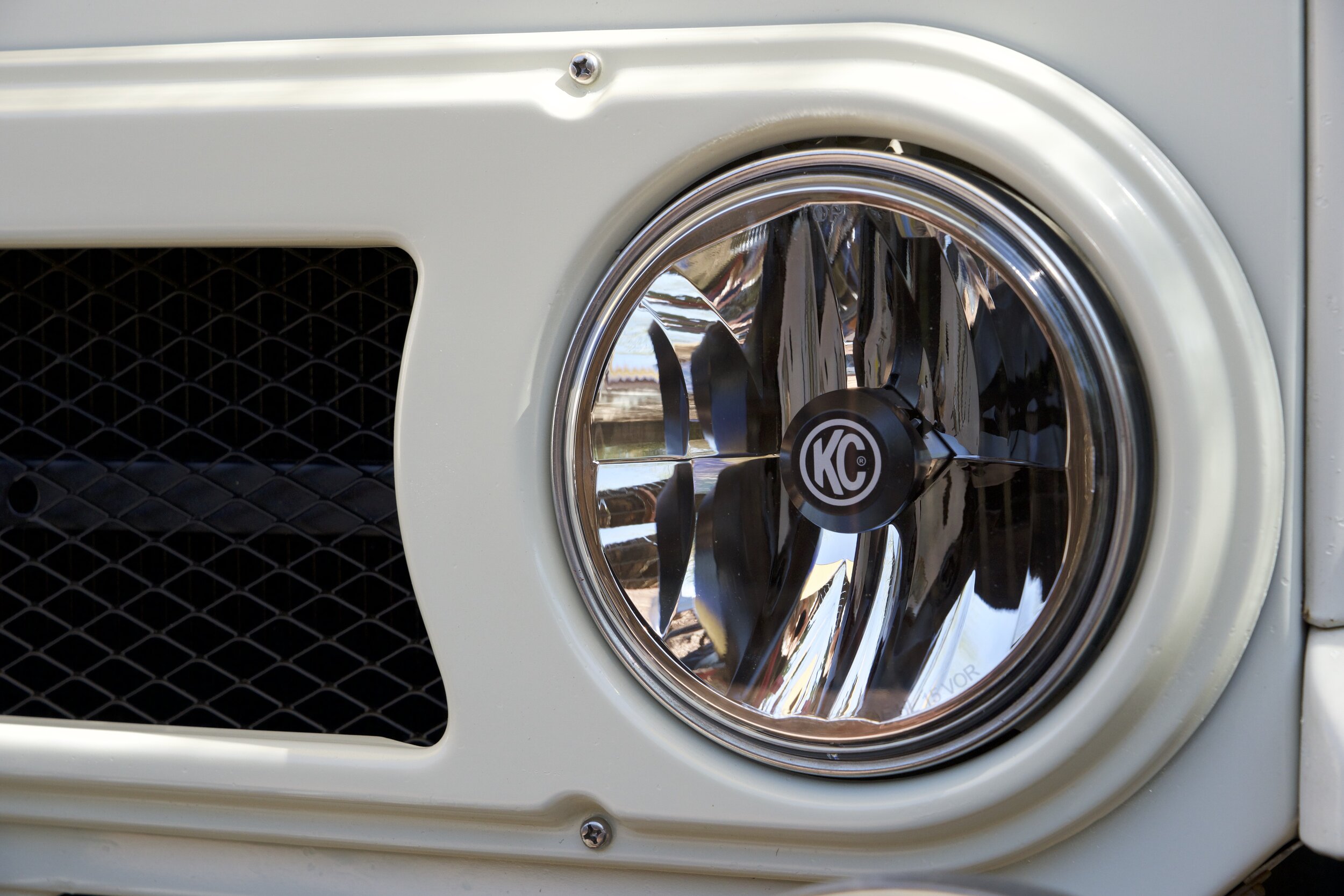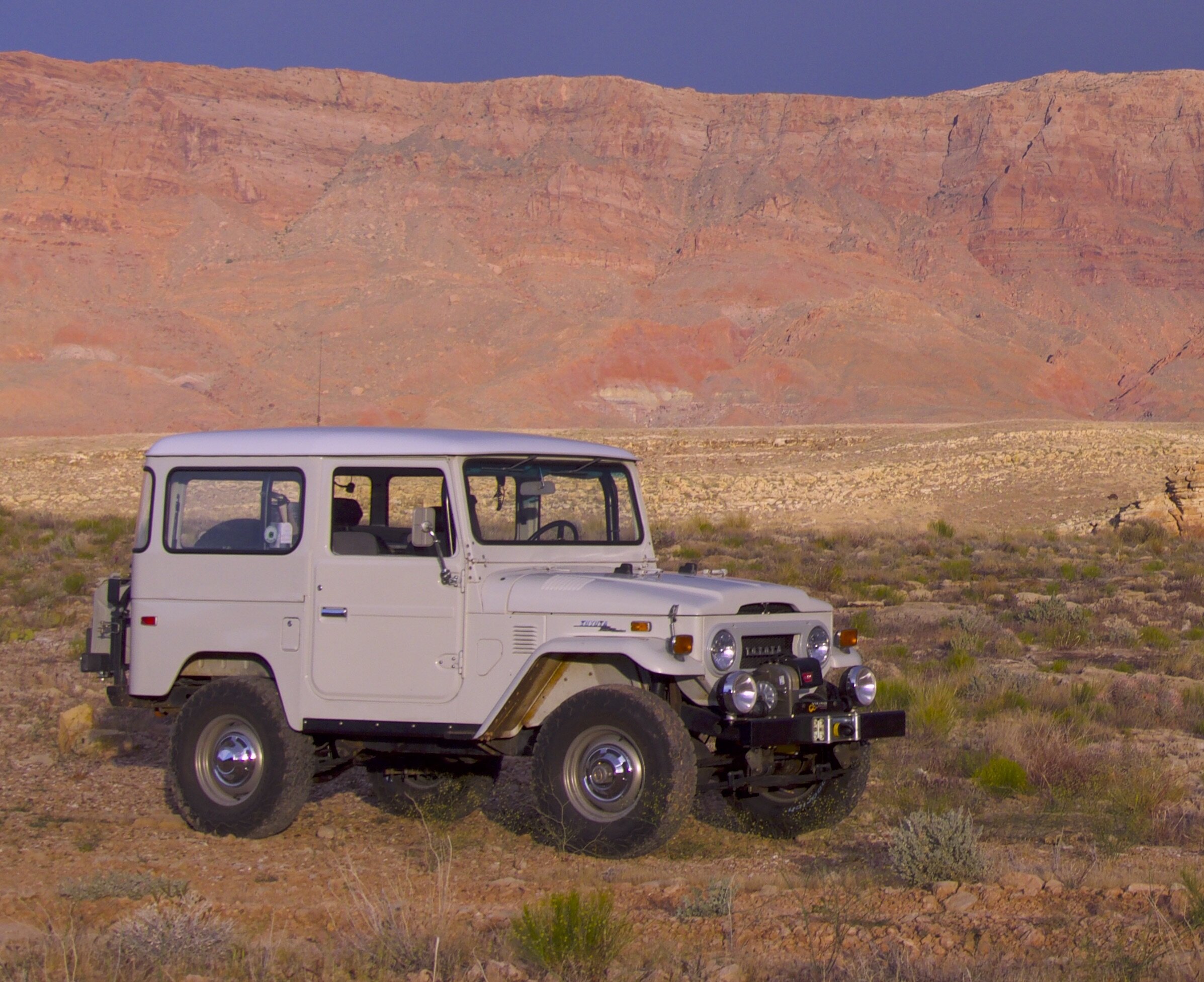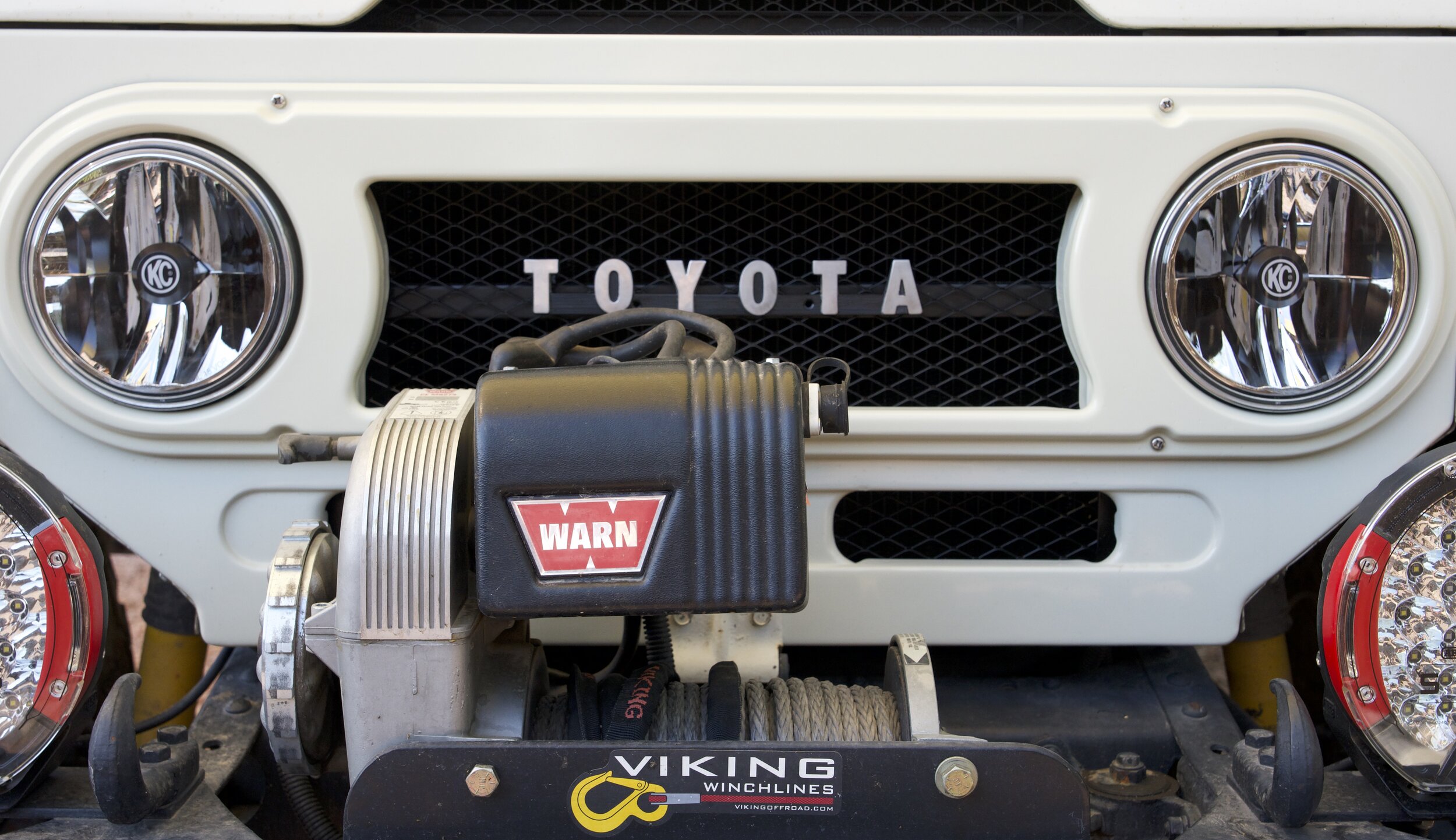
Overland Tech and Travel
Advice from the world's
most experienced overlanders
tests, reviews, opinion, and more
Touching up 48-year-old paint
Most people find it hard to believe my 1973 FJ40 still wears most of its original paint (aside from the newer doors I installed and had matched, and a couple of repaired areas). Despite having sat uncovered in the Arizona sun for at least 26 years of its life, the paint still glows with a hand application of Classic Car Wax (until the brand disappeared) or Mother’s California Gold—no ceramic coatings, no polymers, just good old-fashioned “wax on; wax off” cleaner and carnauba. I’ve lost track of those who ask me where I had my Land Cruiser restored.
That is, until they walked around front.
Thanks to the thousands of miles of dirt roads the 40 has covered, it has over the decades collected what seems like thousands of tiny stone chips, which stand out like a bad case of acne once one gets closer than ten feet. I imagine as the paint has aged it has probably become more brittle and thus more prone to chipping, as well. When I had the new doors painted a few years ago I got an extra pint of the match and painstakingly dabbed dozens of chips on the edge of the hood, the front clip and fenders, and the windshield surround. In the intervening years, however, another couple hundred have appeared. The can of paint had long since petrified, so I went online to one of the paint companies specializing in touch-up matching, and looked up the chart for a 1973 Land Cruiser in white. The first company led me to a color coded 040, so I ordered a tiny $20 bottle of the stuff.
Not even close. It was way, way too white.
Back to the research. Several people online swore my color should be T12, Cygnus White, and linked me to a color chart of 40-series colors in the early 70s. And there it was, overlapping from 1970 to 1975. Perfect. Except . . . in looking for the paint I found this offering at Cruiser Corps:
Well, my fiberglass top is and always has been a distinctly whiter shade of white than the body, which is distinctly off-white. Still, several forum members swore Cygnus White was the body color on their early 70s FJs. So, I ordered another $20 mini bottle.
And it, too, was too white. Not, perhaps as too-white as the first one, but not a match. Now I was down 40 bucks with nothing to show for it. Back to the forums, and this time someone suggested Arctic White, 022, which on another chart was listed as a 1973 color for Toyotas—but not specifically Land Cruisers. Ugh. Do I risk another 20 bucks for a few CCs of maybe?
No. I decided on a different route. I pulled off the locking fuel filler lid and took it up to Finish Master, a professional auto paint supply store in Tucson. When I explained to the counter guy—whose name I should have recorded—he at first demurred. “We’re mostly a professional supply source; we don’t usually do small batches. And what we make is designed for spraying; it’s pretty thin. What kind of vehicle is it?”
When I said, “It’s a 48-year-old Land Cruiser,” he perked up. “Really?” He thought for a moment. “Well, look, I can match the paint with our camera, and you could just build up layers if it’s too thin. But the smallest amount I can sell you is a quart, and it will be $40.”
“Done,” I said. He thought for another moment, then said, “You know, since you don’t need that much for stone chips, I could take some of it out and make up two cans of aerosol. It would be an extra $24.”
“Seriously?” I said. “That would be great!”
He took the filler flap and scanned it. “When can I come back?” I asked.
“Do you have ten minutes? We’ll make it up right now.”
This just kept getting better. I waited; ten minutes later I had my paint, which proved to be an excellent match.
I used the can to dab chips on the edge of the hood and fenders. I tried to fill in each one to slightly above the level of the surrounding paint, and then sanded it all flush with 1500-grit sandpaper, brought back the finish with rubbing compound, and finally applied the Mother’s California Gold.
Looking at the front apron, which was particularly loaded with acne, I decided to try the aerosol. So I pulled off the apron, cleaned it and sanded it with 800-grit wet-and-dry paper, and started spraying on layers. The paint went on well but, as I’d been warned, in thin layers, and the stone chips still showed up behind it, so I bought some lightweight polyester filler and faired in most of the tiny nicks, then resanded and repainted. After three or four more coats I smoothed out the paint with rubbing compound, then went at it with the Mother’s California Gold.
And, well, it looked pretty darn good when I was finished—certainly not the mirror finish a professional painter would have achieved, but it shines well and looks ten thousand percent better than it did. Since it is such a discrete part of the front of the vehicle, any slight contrast with adjoining panels is difficult to see.
Overall the improvement is astonishing. From a couple of feet away you can see the repairs, but from ten the work is nearly invisible.
New Clayton T. Porter short story—free to subscribers
Already read Trail of the Jaguar? How about a free prequel short story, The Poacher Affair?
Sign up for Jonathan’s author e-news to receive the free download link instantly for this fun e-book story with many of the characters you love from the original novel.
https://jonathanhansonauthor.com
Signup link is at the top. Enjoy!
Trail of the Jaguar now available in audio and e-book versions
We heard from fans that audiobook and e-book formats would be most appreciated—and so we are happy to announce that you can purchase directly from us either format for immediate download. Want both? We bundled them together in a discounted package as well!
7-inch universal LED headlamps from KC HiLites (yes, THAT KC HiLites)
Over four decades of ownership, I’ve made a number of significant modifications to my 1973 FJ40—a different (but still Land Cruiser) transmission, a drop-down tailgate to replace the mini swing doors, post 1975 single-piece front doors to reduce rattles, late-model European mirrors, and a few others. I’ve also added several aftermarket accessories—a Stout Equipment rear swingaway tire/jerry can carrier (brilliant, and no longer made), the Warn 8274 winch, Old Man Emu suspension, and, at various times, a roof rack and front brush guard.
Through all the years, however, I’ve tried to maintain more or less a semblance of a period look to the vehicle. After running alloy wheels for several years, I reverted to aftermarket but correct non-USA 16 x 6-inch steel wheels that accept the factory hubcaps—and nothing says quirky original Land Cruiser styling than those hubcaps. I stuck with the factory seats but had them re-upholstered in more comfortable fabric than the sweaty—and shamefully cheap—factory vinyl. (Quality upholstery was the last aspect of manufacturing Toyota mastered.) I stuck with the stock, 17-inch diameter hula hoop of a steering wheel but stitched a one-piece leather cover on it for a bit of extra grip. Power steering? Never.
In one aspect I never hesitated to alter the factory components or look: safety. I installed a full front roll cage and three-point inertia-reel lap and shoulder harnesses, replacing the original lap belts. I added late-model head restraints (interestingly the seat backs had provision for them). And I swapped out the four-wheel drum brakes for four-wheel discs. Much of this did nothing but slightly update the apparent model year of my FJ40, since the 40-series body remained virtually the same right through the end of production in 1983.
Another critical safety consideration was lighting. Shortly after buying the 40 I installed a set of Cibié’s superb Z-beam halogen headlamps, vastly superior to the 1940’s technology sealed-beam originals. Some time later I added a pair of Cibié Super Oscar driving lamps, at the time the pinnacle of automotive lighting technology and virtually standard equipment on rally cars and Paris-Dakar racers at the time. The combination served me well when I was guiding in Mexico, where livestock on even major highways is a common hazard, and later when Roseann and I lived on several remote properties, on the dirt roads to which cattle, deer, and coyotes made occasional suicidal forays.
I used the Super Oscars until they were completely sand-blasted and the reflectors had finally oxidized, and replaced them (yes, I threw them away!) with an equally effective if considerably less romantic set from IPF. The Z-Beams had also gone, replaced with Hellas that, while excellent, never seemed to have quite the same perfect beam control or even spread of light. After the Arizona and Mexico desert sands wore out the Hellas (I’ve owned this vehicle a long time) I installed a pair of Trucklite halogen lamps with complex reflectors and clear lenses, which were probably better than the Cibiés. This eased me away from the traditional faceted lenses of earlier headlamps, but still looked reasonably period.
Trucklite complex-reflector halogen headlamps—excellent for a halogen lamp
Then the LED revolution happened. And the look of driving lamps and headlamps changed forever.
Even after testing several brands of LED driving lamps, I couldn’t bring myself to install them on the FJ40. They just looked too . . . modern. Too much bling compared to the simple reflectors of the IPFs. And the early replacement 7-inch round LED headlamps I reviewed left much to be desired, evidencing massive purple fringing and blotchy patterns.
One salient thing nibbled at the back of my brain however: My FJ40 has a 55-amp alternator (compared to the 120-plus amps of modern alternators), and it is difficult to upgrade because all the power from the alternator runs through the ammeter via a single wire (a rare dumb design from Toyota). When I flicked on the IPFs and their 125-watt bulbs, they sucked up 21 amps of that output, and with the halogen headlamps on high beam, that was another 16 amps. It was a wonder there was power left to get to the spark plugs. Those LED driving lamps required a fraction of the power to produce the same light.
I got over my Luddite stylistic hangups in Australia. There we had bought a 1993 HZJ75 Troop Carrier and had it converted with a pop top and a bunch of other modifications—one of which was a set of ARB Intensity LED driving lamps furnished by the company. On a single, poorly planned drive after dark toward Alice Springs, those lamps—well, I can’t say they paid for themselves, but they would have—anyway, they safely bored a bright 5000ºK hole through the Australian night, illuminating the large marsupials bounding suicidally across our path. When we got home I immediately added an identical pair to the FJ40. The headlamps, however, remained stubbornly incandescent. If LED driving lamps looked like something off the Starship Enterprise, most LED headlamps looked like they belonged on a Klingon Bird of Prey.
However . . .
I’m working on an article for Tread magazine, about upgrading classic 4x4 vehicles such as the FJ40, or Series Land Rovers, Scouts, or CJ Jeeps, to make them more comfortable, safe, and capable for modern use. The FJ40 is getting new gearing, AC, and, just possibly, fuel injection, along with the existing upgrades I mentioned above. Given the goals, I decided it was time to grit my teeth and upgrade the headlamps, and KC Hilites—yes, KC of the classic budget Daylighters with the smiley-face covers—offered to send me a pair of their 7-inch Gravity LED headlamps. When received, I was relieved to note that they look less . . . Klingony . . . than most of their kind.
The Gravity headlamps are virtually a universal, plug-in fit for any vehicle with 7-inch round headlamps, although I found that I need to trim the headlamp buckets on the 40 by just a couple millimeters to clear the backs of the Gravity lamps. Once that was accomplished—the work of five minutes with a jigsaw—they dropped right in.
The width of a black marker tip was all the trimming necessary
I’ve yet to be able to head out to Ravenrock for a full test, but initially the pattern and color look excellent. Power draw on high beam is just 3.6 amps. For both lamps.
And the appearance? Hmm . . . I’ll get back to you . . .
Hint: When using “Search,” if nothing comes up, reload the page, this usually works. Also, our “Comment” button is on strike thanks to Squarespace, which is proving to be difficult to use! Please email me with comments!
Overland Tech & Travel brings you in-depth overland equipment tests, reviews, news, travel tips, & stories from the best overlanding experts on the planet. Follow or subscribe (below) to keep up to date.
Have a question for Jonathan? Send him an email [click here].
SUBSCRIBE
CLICK HERE to subscribe to Jonathan’s email list; we send once or twice a month, usually Sunday morning for your weekend reading pleasure.
Overland Tech and Travel is curated by Jonathan Hanson, co-founder and former co-owner of the Overland Expo. Jonathan segued from a misspent youth almost directly into a misspent adulthood, cleverly sidestepping any chance of a normal career track or a secure retirement by becoming a freelance writer, working for Outside, National Geographic Adventure, and nearly two dozen other publications. He co-founded Overland Journal in 2007 and was its executive editor until 2011, when he left and sold his shares in the company. His travels encompass explorations on land and sea on six continents, by foot, bicycle, sea kayak, motorcycle, and four-wheel-drive vehicle. He has published a dozen books, several with his wife, Roseann Hanson, gaining several obscure non-cash awards along the way, and is the co-author of the fourth edition of Tom Sheppard's overlanding bible, the Vehicle-dependent Expedition Guide.


















